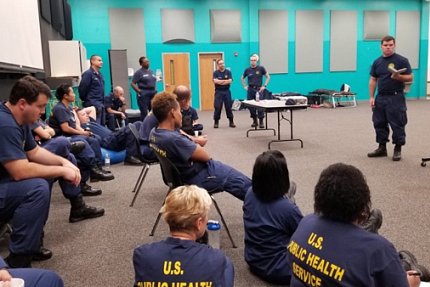PHS, FEMA
NIEHS’ers Among First Responders for Hurricane Relief

NIEHS response to the 2017 hurricanes included officers in the Public Health Service and volunteers who worked with the Federal Emergency Management Administration. “When Hurricane Irma hit, I got rapid deployment orders Sept. 11,” said Mark Miller, NIEHS chief of staff. “I was on a plane to Atlanta less than 8 hours later.” From Atlanta, he traveled to South Florida, where he led operation of a medical shelter in a high school. “This level of response shows what the PHS can do as a team to support impacted communities,” he said.
In addition to his role at NIEHS, Cdr. Miller serves as a planning officer on a PHS rapid deployment force. For him and his 130 teammates, that meant early activation and deployment within hours of Irma’s landfall.
At a shelter in East Lee County High School, just east of Ft. Myers, Miller’s team worked with the state department of health and local organizations to care for nearly 300 patients and family members. Within 10 days, most were able to return home or make other arrangements, so Miller and approximately 65 clinicians moved to Florida International University (FIU) in Miami. There they managed a medical shelter for more than 75 individuals in need of dialysis and other medical attention.
“In the wake of Hurricane Irma, many U.S. Virgin Islands residents in need of dialysis were moved to Puerto Rico, because so many clinics were destroyed,” Miller said. “But as Hurricane Maria approached, it was clear that Puerto Rico would not be safe either.” So 97 dialysis patients were relocated from Puerto Rico to FIU via military aircraft.
Another PHS officer at NIEHS, Cdr. John McLamb, deployed to Puerto Rico on Oct. 25 to support response efforts in the wake of Hurricane Maria. He conducted environmental health and safety assessments in hospitals and evaluated drinking water systems on the island. He worked 14-plus days in and around areas where the infrastructure was heavily damaged. For example, he said it was common that 4 out of 5 utility poles were knocked down.
Many across HHS responded to the call for volunteers from the Federal Emergency Management Agency. Two from NIEHS were selected: Julie Nixon, emergency management program specialist, and James Williams, grants officer.
“To be here on the ground, ready to help these people survive this storm from the moment it hit, has been a life-changing experience,” said Nixon. Williams had previous experience with disaster relief through a similar deployment after Hurricane Katrina. “I was assigned to a team of six along Florida’s Gulf coast,” Williams said. “These areas were drastically impacted by the hurricane, many more by flooding than wind.”
“I’m so proud to work for an institute that supports disaster relief the way NIEHS does,” Miller said.—Ian Thomas
